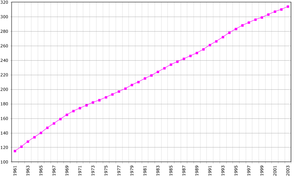
Demographics of the Bahamas
Encyclopedia
This article is about the demographic
features of the population
of The Bahamas
, including population density
, ethnicity
, education level, health of the populace, economic status, religious affiliations and other aspects of the population.
 Eighty-five percent of the Bahamian
Eighty-five percent of the Bahamian
population is of Africa
n heritage. About two-thirds of the population lives on New Providence Island (the location of Nassau
), and about half of the remaining one-third lives on Grand Bahama
(the location of Freeport).
The islands were sparsely settled and a haven for pirates until the late 18th century when thousands of British loyalists and their slaves were given compensatory land grants following the American Revolution. At the turn of the 20th century the total population was only 53,000.
School attendance is compulsory between the ages of five and 16. There are 158 public schools and 52 private schools in The Bahamas catering to more than 66,000 students. The College of the Bahamas
, established in Nassau in 1974, provides programmes leading to associate's degree
s and bachelor's degree
s; the college is now converting from a two-year to a four-year institution.
 The following demographic statistics are from the CIA World Factbook, unless otherwise indicated.
The following demographic statistics are from the CIA World Factbook, unless otherwise indicated.
The CIA World Factbook does not distinguish between Haitian Creole, and Bahamian Creole
known simply as "dialect" to its 400,000 users. In addition, Spanish
is spoken among Cuba
n and Dominican
immigrants.
Demographics
Demographics are the most recent statistical characteristics of a population. These types of data are used widely in sociology , public policy, and marketing. Commonly examined demographics include gender, race, age, disabilities, mobility, home ownership, employment status, and even location...
features of the population
Population
A population is all the organisms that both belong to the same group or species and live in the same geographical area. The area that is used to define a sexual population is such that inter-breeding is possible between any pair within the area and more probable than cross-breeding with individuals...
of The Bahamas
The Bahamas
The Bahamas , officially the Commonwealth of the Bahamas, is a nation consisting of 29 islands, 661 cays, and 2,387 islets . It is located in the Atlantic Ocean north of Cuba and Hispaniola , northwest of the Turks and Caicos Islands, and southeast of the United States...
, including population density
Population density
Population density is a measurement of population per unit area or unit volume. It is frequently applied to living organisms, and particularly to humans...
, ethnicity
Ethnic group
An ethnic group is a group of people whose members identify with each other, through a common heritage, often consisting of a common language, a common culture and/or an ideology that stresses common ancestry or endogamy...
, education level, health of the populace, economic status, religious affiliations and other aspects of the population.

The Bahamas
The Bahamas , officially the Commonwealth of the Bahamas, is a nation consisting of 29 islands, 661 cays, and 2,387 islets . It is located in the Atlantic Ocean north of Cuba and Hispaniola , northwest of the Turks and Caicos Islands, and southeast of the United States...
population is of Africa
Africa
Africa is the world's second largest and second most populous continent, after Asia. At about 30.2 million km² including adjacent islands, it covers 6% of the Earth's total surface area and 20.4% of the total land area...
n heritage. About two-thirds of the population lives on New Providence Island (the location of Nassau
Nassau, Bahamas
Nassau is the capital, largest city, and commercial centre of the Commonwealth of the Bahamas. The city has a population of 248,948 , 70 percent of the entire population of The Bahamas...
), and about half of the remaining one-third lives on Grand Bahama
Grand Bahama
Grand Bahama is one of the northernmost of the islands of the Bahamas, and the closest major island to the United States, lying off the state of Florida. Grand Bahama is the fifth largest island in the Bahamas island chain of approximately 700 islands and 2,400 cays...
(the location of Freeport).
The islands were sparsely settled and a haven for pirates until the late 18th century when thousands of British loyalists and their slaves were given compensatory land grants following the American Revolution. At the turn of the 20th century the total population was only 53,000.
School attendance is compulsory between the ages of five and 16. There are 158 public schools and 52 private schools in The Bahamas catering to more than 66,000 students. The College of the Bahamas
College of the Bahamas
The College of The Bahamas is the national public institution of higher education in The Commonwealth of The Bahamas with campuses throughout the archipelago. The main campus is located in the capital city of Nassau, on the island of New Providence....
, established in Nassau in 1974, provides programmes leading to associate's degree
Associate's degree
An associate degree is an undergraduate academic degree awarded by community colleges, junior colleges, technical colleges, and bachelor's degree-granting colleges and universities upon completion of a course of study usually lasting two years...
s and bachelor's degree
Bachelor's degree
A bachelor's degree is usually an academic degree awarded for an undergraduate course or major that generally lasts for three or four years, but can range anywhere from two to six years depending on the region of the world...
s; the college is now converting from a two-year to a four-year institution.
CIA World Factbook demographic statistics

Population
- 309,156
- country comparison to the world: 177
- note: Estimates for this country explicitly take into account the effects of excess mortality due to AIDS; this can result in lower life expectancy, higher infant mortality and death rates, lower population and growth rates, and changes in the distribution of population by age and sex than would otherwise be expected (July 2009 est.)
Age structure
- 2-14 years: 25.9% (male 40,085/female 39,959)
- 15-64 years: 67.2% (male 102,154/female 105,482)
- 65 years and over: 6.9% (male 8,772/female 11,704) (2009 est.)
Net migration rate
- -2.13 migrant(s)/1,000 population (2009 est.)
- county comparison to the world: 140
Urbanization
- Urban population: 84% of total population (2008)
- Rate of urbanization: 1.4% of annual rate of change (2005-2010 est.)
Sex ratio
- At birth: 1.02 male(s)/female
- Under 15 years: 1 male(s)/female
- 15-64 years: 0.97 male(s)/female
- 65 years and over: 0.69 male(s)/female
- Total population: 0.96 male(s)/female (2009 est.)
Infant mortality rate
- Total: 23.17 deaths/1,000 live births
- county comparison to the world: 93
- Male: 28.21 deaths/1,000 live births
- Female: 18.04 deaths/1,000 live births (2006 est.)
Life expectancy at birth
- Total population: 65.78 years
- county comparison to the world: 164
- Male: 62.63 years
- Female: 68.98 years (2009 est.)
Total fertility rate
- 2.1 children born/woman (2009 est.)
- county comparison to the world: 121
HIV/AIDS
- Adult prevalence rate: 3% (2007 est.)
- county comparison to the world: 24
- People living with HIV/AIDS: 6,200 (2007 est.)
- county comparison to the world: 118
- Deaths: less than 200 (2007 est.)
- county comparison to the world: 126
Ethnic groups
- BlacksBlack peopleThe term black people is used in systems of racial classification for humans of a dark skinned phenotype, relative to other racial groups.Different societies apply different criteria regarding who is classified as "black", and often social variables such as class, socio-economic status also plays a...
or Afro-Bahamians 85%, WhitesWhite peopleWhite people is a term which usually refers to human beings characterized, at least in part, by the light pigmentation of their skin...
or European BahamianEuropean BahamianEuropean Bahamians or Bahamians of European Descent are Bahamians whose ancestry lie within the continent of Europe. Most are the descendants of the British Puritans and American Loyalists who arrived in 1649 and 1783 respectively. A small portion of the European Bahamian population are the...
12%, Asians or Indo-CaribbeanIndo-CaribbeanIndo-Caribbean people or Indo-Caribbeans are Caribbean people with roots in India or the Indian subcontinent. They are mostly descendants of the original indentured workers brought by the British, the Dutch and the French during colonial times...
3%
Religions
- Baptist 35.1%, Anglican 15.1%, Roman Catholic 13.4%, Pentecostal 8.1%, Church of God 4.8%, Methodist 4%, other Christian 15.2%, none or unspecified 1.6%, Buddhism 2%, other 0.7% (2000 census)
Languages
- EnglishEnglish languageEnglish is a West Germanic language that arose in the Anglo-Saxon kingdoms of England and spread into what was to become south-east Scotland under the influence of the Anglian medieval kingdom of Northumbria...
(official), Creole (among HaitiHaitiHaiti , officially the Republic of Haiti , is a Caribbean country. It occupies the western, smaller portion of the island of Hispaniola, in the Greater Antillean archipelago, which it shares with the Dominican Republic. Ayiti was the indigenous Taíno or Amerindian name for the island...
an immigrants)
The CIA World Factbook does not distinguish between Haitian Creole, and Bahamian Creole
Bahamian Creole
Bahamian is an English-based creole language spoken by approximately 400,000 people in the Bahamas and the Turks and Caicos Islands.Bahamian is spoken by both white and black Bahamians, although in slightly different forms. Bahamian also tends to be more prevalent in certain areas of the Bahamas...
known simply as "dialect" to its 400,000 users. In addition, Spanish
Spanish language
Spanish , also known as Castilian , is a Romance language in the Ibero-Romance group that evolved from several languages and dialects in central-northern Iberia around the 9th century and gradually spread with the expansion of the Kingdom of Castile into central and southern Iberia during the...
is spoken among Cuba
Cuba
The Republic of Cuba is an island nation in the Caribbean. The nation of Cuba consists of the main island of Cuba, the Isla de la Juventud, and several archipelagos. Havana is the largest city in Cuba and the country's capital. Santiago de Cuba is the second largest city...
n and Dominican
Dominican Republic
The Dominican Republic is a nation on the island of La Hispaniola, part of the Greater Antilles archipelago in the Caribbean region. The western third of the island is occupied by the nation of Haiti, making Hispaniola one of two Caribbean islands that are shared by two countries...
immigrants.
Literacy
- Definition: age 15 and over can read and write
- Total population: 95.6%
- Male: 94.7%
- Female: 96.5% (2003 est.)

